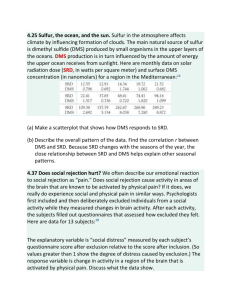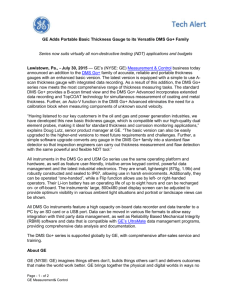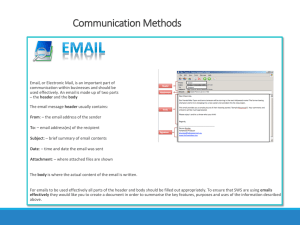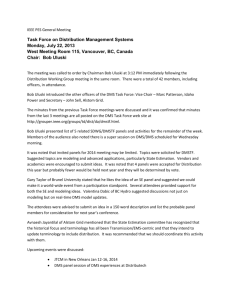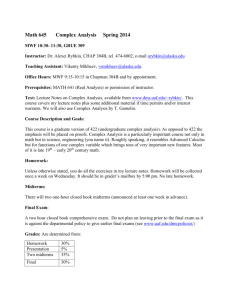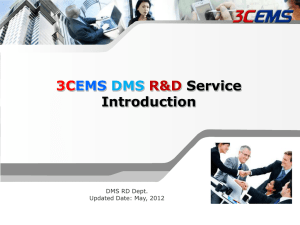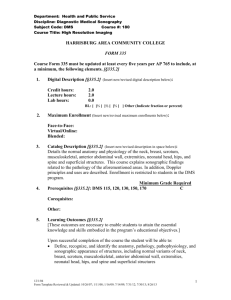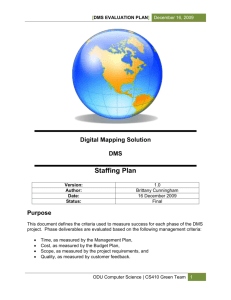DMS ASCE - University of Missouri
advertisement
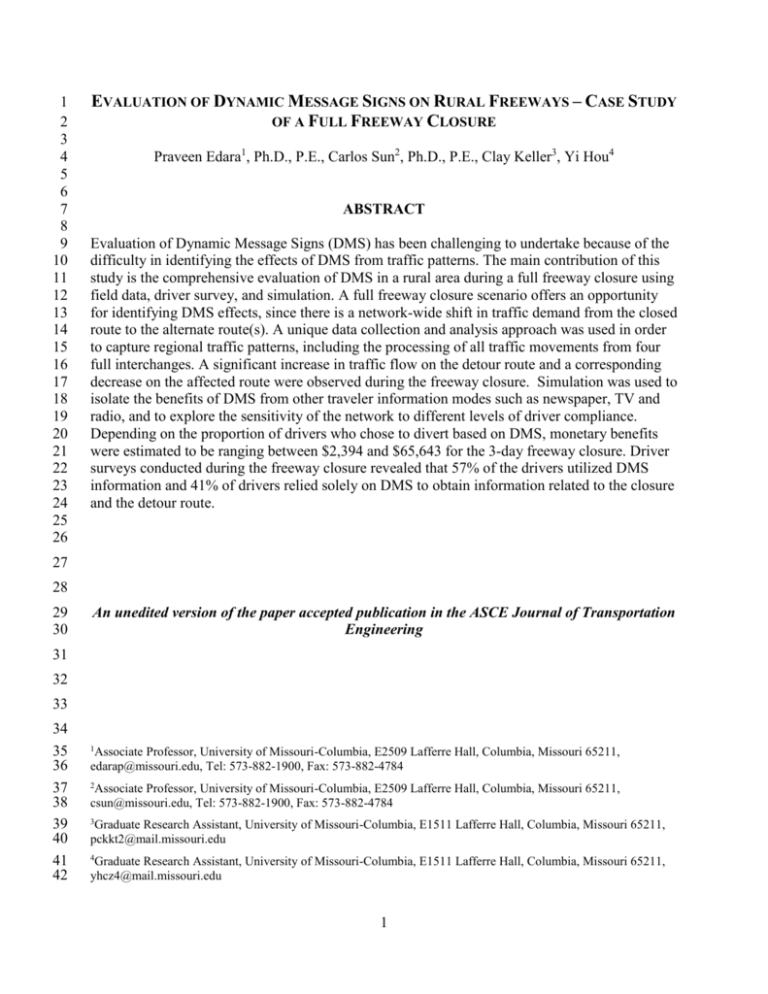
1 2 3 4 5 6 7 8 9 10 11 12 13 14 15 16 17 18 19 20 21 22 23 24 25 26 EVALUATION OF DYNAMIC MESSAGE SIGNS ON RURAL FREEWAYS – CASE STUDY OF A FULL FREEWAY CLOSURE Praveen Edara1, Ph.D., P.E., Carlos Sun2, Ph.D., P.E., Clay Keller3, Yi Hou4 ABSTRACT Evaluation of Dynamic Message Signs (DMS) has been challenging to undertake because of the difficulty in identifying the effects of DMS from traffic patterns. The main contribution of this study is the comprehensive evaluation of DMS in a rural area during a full freeway closure using field data, driver survey, and simulation. A full freeway closure scenario offers an opportunity for identifying DMS effects, since there is a network-wide shift in traffic demand from the closed route to the alternate route(s). A unique data collection and analysis approach was used in order to capture regional traffic patterns, including the processing of all traffic movements from four full interchanges. A significant increase in traffic flow on the detour route and a corresponding decrease on the affected route were observed during the freeway closure. Simulation was used to isolate the benefits of DMS from other traveler information modes such as newspaper, TV and radio, and to explore the sensitivity of the network to different levels of driver compliance. Depending on the proportion of drivers who chose to divert based on DMS, monetary benefits were estimated to be ranging between $2,394 and $65,643 for the 3-day freeway closure. Driver surveys conducted during the freeway closure revealed that 57% of the drivers utilized DMS information and 41% of drivers relied solely on DMS to obtain information related to the closure and the detour route. 27 28 29 30 An unedited version of the paper accepted publication in the ASCE Journal of Transportation Engineering 31 32 33 34 35 36 37 38 39 40 41 42 1 Associate Professor, University of Missouri-Columbia, E2509 Lafferre Hall, Columbia, Missouri 65211, edarap@missouri.edu, Tel: 573-882-1900, Fax: 573-882-4784 2 Associate Professor, University of Missouri-Columbia, E2509 Lafferre Hall, Columbia, Missouri 65211, csun@missouri.edu, Tel: 573-882-1900, Fax: 573-882-4784 3 Graduate Research Assistant, University of Missouri-Columbia, E1511 Lafferre Hall, Columbia, Missouri 65211, pckkt2@mail.missouri.edu 4 Graduate Research Assistant, University of Missouri-Columbia, E1511 Lafferre Hall, Columbia, Missouri 65211, yhcz4@mail.missouri.edu 1 Evaluation of DMS on Rural Freeways 43 44 45 46 47 48 49 50 51 52 53 54 55 56 57 58 59 60 61 62 63 64 65 66 67 68 69 70 71 72 73 74 75 76 77 78 79 80 81 82 83 84 85 86 87 88 89 Edara et al. Background of Dynamic Message Signs Dynamic message signs (DMS) are used to provide traveler information such as incidents, work zones, road conditions, delays, travel times, alternate routes, and other events. Due to their versatility, DMS have become a prominent aspect of advanced traveler information systems and have continued to see growth. The total investment by state departments of transportation (DOTs) in deploying DMS was estimated at $330 million by 2002 (Paniati 2004). In Missouri and several other states, DMS are primarily used to provide real-time traveler information on traffic conditions to the traveling public. The Missouri Department of Transportation (MoDOT) Engineering Policy Guide (MoDOT 2011) provides guidelines on the basic requirements, message formats, acceptable use of words, and others. An example of a MoDOT DMS displaying detour information to motorists is shown in Figure 1. A review of the research literature on DMS evaluations shows that majority of the DMS deployments by DOTs across the country are in urban areas with very limited rural deployments. This is not a surprise given the congestion in urban areas and the need to inform motorists of those conditions. However, DMS offer several potential benefits in rural areas as well. They provide useful traveler information to motorists during incidents, work zones, road closures, inclement weather, evacuations and other occurrences. The information not only makes the motorists more aware of the downstream traffic conditions but also encourages them to consider switching to alternate routes to reduce delays. One challenge in evaluating DMS in rural areas is the lack of permanent traffic count stations to obtain traffic data. In urban areas, the dense deployment of traffic sensors on freeways provides valuable data necessary for analyzing traffic impacts of DMS. In contrast, in rural areas there is very sparse deployment of sensors on freeways, thus there may not be any deployment within the study corridors. As will be demonstrated in this paper, this challenge was overcome through the use of Closed Circuit Television (CCTV) cameras and portable traffic monitoring equipment. Existing research on DMS evaluation can be separated into two categories – studies that collected and analyzed traffic data and studies that conducted stated preference surveys to obtain public perceptions towards DMS. Studies belonging to each category are summarized next. Evaluations based on traffic data In terms of studies that used traffic data, Lee and Kim (2006) performed a work zone study on Interstate 15 in Devore, California to determine the impact of an automated work zone information system (AWIS). An automated work zone information system (AWIS) was implemented to improve work zone safety by reducing end of queue crash potential and provide speed advisories using DMS. AWIS was also successful at diverting traffic away from the construction work zone. Hardy et al. (2006) studied the use of DMS to warn drivers of animals in efforts to reduce animal-vehicle crashes (AVCs) in rural areas. Two permanent DMS and one portable DMS were used to administer one control message and three treatment messages, two of which alerted motorists of potential animals. The DMS displaying animal warning messages were found to have an effect on the speed of drivers, with the portable DMS showing a consistently higher reduction. 2 Evaluation of DMS on Rural Freeways 90 91 92 93 94 95 96 97 98 99 100 101 102 103 104 105 106 107 108 109 110 111 112 113 114 115 116 117 118 119 120 121 122 123 124 125 126 127 128 129 130 131 132 133 134 Edara et al. Yu et al. (2010) conducted an evaluation of real-time advanced traveler information systems on two routes leading to Ocean City, Maryland. DMS were explicitly accounted for by being a control variable. When DMS were used the entire system throughput increased by 200 vehicles per hour (vph). The study concluded that DMS displaying real-time information leads to better use of roadway capacity during congested periods. Li et al. (2010) studied the effectiveness of portable DMS (the authors refer to them as portable changeable message signs) for one lane, two-way work zones on rural highways in Kansas. The researchers placed one portable DMS each at two rural work zone locations. They analyzed driver speeds with the portable DMS on, off, and absent and concluded that the portable DMS significantly reduced driver speeds. The effect was greater if the portable DMS was turned on than when off. Horowitz et al. (2003) evaluated DMS on rural Interstate 94 and multiple parallel highways in Racine County, Wisconsin. This study was unique as the area was largely devoid of other realtime information, there were clearly alternative routes, and had enough traffic to cause congestion during peak hours. The signage system utilized five microwave detectors and four portable DMS. Alternative routes were marked using fixed signs. The study acknowledged while many drivers are responsive to traffic delay warnings, there are many more drivers that will not divert even if it would be beneficial. The study concluded that during peak periods, diversion rates were between 7% and 10% of freeway traffic. Evaluations based on stated preference surveys Al-Deek et al. (2009) evaluated the impact of DMS on satisfaction and diversion of toll road motorists. Stated preference surveys were distributed to toll road users in the central Florida area to evaluate DMS performance relative to other available traffic information. The stated preference surveys included demographic information, trip characteristics, the user’s source for acquiring traffic information on toll roads, and the perception of benefits and satisfaction from the DMS information. The surveys were handed out in two phases. In the first phase called predeployment, there was only one operational DMS on the four toll roads being examined. In the second phase or post-deployment, 29 DMS were operational on the four toll roads. They found the accuracy of travel time information was more important to users in pre-deployment than post-deployment. It was also discovered that special event information became more important towards overall satisfaction in post-deployment. Peng et al. (2004) performed a study in Milwaukee regarding motorist response on arterial DMS. The survey consisted of 306 responses asking 14 different questions concerning the motorists’ driving behavior, demographic information, and attitudes toward DMS. An ordered Logit model was created to determine the correlation between a motorist’s attitude toward the DMS and willingness to divert due to information provided by the DMS. The study found that there was a clear but not strong correlation for this phenomenon, and drivers were particularly inclined to divert routes if they would save time or avoid congestion. 3 Evaluation of DMS on Rural Freeways 135 136 137 138 139 140 141 142 143 144 145 146 147 148 149 150 151 152 153 154 155 156 157 158 159 160 161 162 163 164 165 166 167 168 169 170 171 172 173 174 175 176 177 178 179 180 Edara et al. Chatterjee et al. (2002) studied the driver response to DMS information in London notifying motorists of planned events and network issues. Three surveys were disseminated to the public. The first inquired about attitudes and responses to the DMS, the second asked motorists how they would respond to different DMS messages, and the third asked motorists how if they would divert to an “Immediate Warning” message. London residents believed that DMS could be useful and were in favor of investing in DMS. The results of observed diversion rate was roughly 20% of the rate predicted from stated preference survey data. Benson (1996) interviewed 517 respondents in the Washington, D.C. area to determine attitudes and responses to DMS. This study reinforced the fact motorists prefer more detailed and up to date information that is reliable and easy to understand. The study also stated that demographic information had little to do with motorist attitudes on DMS, except in the case of education level. Wang et al. (2009) investigated the effects of different messages displayed on DMS in Rhode Island. A web based survey asked respondents about their preference of DMS’ display, frame changes and graphic integration. It also asked the respondents what caused them to slow down. Speeds were collected and analyzed 5 minutes before and after messages were displayed on I-95. This data revealed that drivers slowed down in more than half the cases, especially when a danger message was displayed. The survey concluded that elder drivers were more likely to slow down in response to DMS, and text-only messages were preferred over graphic-integrated and graphic-aided messages. In summary, field evaluations have focused on measuring safety parameters and traffic diversion rates achieved due to DMS use for providing work zone information, animal advisory, and travel time information. There are no studies addressing DMS benefits for a full freeway closure. Also, majority of the study locations reported in the literature are from urban areas. Thus, the current study aims to fill the gap in the literature of evaluating DMS benefits on a full closure of a rural freeway. Studies that utilized stated-preference surveys for measuring user perceptions of DMS were helpful in designing the motorist survey used in this study. The main objective of this study is to better understand the effectiveness of DMS in diverting traffic to a detour route by examining the full freeway closure of the I-57 Bridge in rural Southeast Missouri during the summer of 2011. Missouri DOT used both permanent and portable DMS signs to provide traveler information about the bridge closure on several routes in the study area. Traffic data was collected from CCTV cameras, pneumatic tubes, and additional video cameras before, during, and after the bridge closure. This data was analyzed to obtain traffic diversion percentages and to build simulation models to quantify the benefits resulting from DMS deployment. Description of the Full Freeway Closure Project In order to quantify the benefits of DMS on rural freeways events that induced traffic diversion onto alternate routes were investigated. Low traffic volumes on rural freeways do not necessarily require diversions to other routes since even the reduced capacities, due to lane closures for example, could still accommodate demands. This is a key difference between DMS evaluations in urban and rural areas. For example, the average daily traffic on I-55 in the study 4 Evaluation of DMS on Rural Freeways Edara et al. 181 182 corridor was about 10,000 for the busiest day of the week. Therefore finding events that necessitate traffic diversion is more challenging in rural areas than in urban areas. 183 184 185 186 187 188 189 190 191 192 193 One event that would require traffic to divert to alternate routes is a full freeway closure since drivers have no choice but to divert to a detour route to reach their destinations. Such a closure occurred from August 16, 2011 to August 18, 2011 on the Interstate 57 crossing over the Mississippi River in Missouri. All lanes on the bridge were closed to traffic in both directions in order to make bridge repairs. The bridge closure project impacted traffic from and to Missouri. MoDOT informed motorists more than two weeks prior to the planned bridge closure via several media outlets. On the days of bridge closure, MoDOT implemented a traffic control plan as shown in Figure 2. The plan included the use of permanent DMS located on the study routes (I55, I-57, US 60), portable DMS, and static signs. Note the difference in the information provided by the DMS versus portable DMS and static signs. Clear instructions on the detour routes were provided at several key DMS locations giving advanced notice to en-route drivers. 194 195 196 197 198 199 200 201 202 203 With the detour, the northbound traffic on I-55 that would normally use I-57 to travel to Illinois would continue north to Cape Girardeau and take MO-74, then IL-146, and IL-3 to I-57. The same detour route (in the opposite direction) is used by the southbound traffic coming from Illinois. Figure 3 compares the I-57 route and the detour route recommended by MoDOT for a trip between Sikeston, Missouri, and Mound City, Illinois. The detour route adds approximately 38 miles to the trip length. This route was the best available alternative for traffic. Expecting an increase in traffic volumes on the detour route, MoDOT encouraged drivers to consider other alternate routes. However, there were not many additional options available for motorists. One other option encouraged by MoDOT in news releases was the Dorena-Hickman Ferry crossing. 204 205 206 207 208 209 210 211 212 213 214 215 216 217 218 219 220 221 222 223 224 225 Traffic Data Collection and Analysis Traffic data was collected for both with and without bridge closure scenarios. Three methods were used to collect data: 1) portable cameras were deployed at interchange locations to measure traffic flows for critical movements, 2) permanent MoDOT CCTV cameras at the interchanges were recorded and processed for traffic flows, and 3) temporary pneumatic tube counters were deployed at certain mainline locations upstream from entrance and exit ramps. The three methods produced a large dataset from which enabled the tracking of the regional travel patterns before, during and after the closure. The MoDOT CCTV cameras at four locations were recorded on three days with and without the closure. The days without bridge closure were used as the control data and were recorded both before and after the closure. The four locations, as shown in Figure 4, were: 1) I-55/US 60 interchange (exit 66), 2) I-55/US 62 interchange (exit 67), 3) I-55/Rt. AB camera viewing the Sprigg St. interchange (exit 93), and 4) I-55/MO 74 interchange (exit 95). Similar to rural freeways in many states, these rural I-55 locations did not have permanent traffic count stations and therefore CCTV cameras and other portable traffic monitoring equipment were used to collect data. A total of twenty movements were required to fully capture the traffic diversion effects of bridge closure. Due to this large number of movements for which traffic flows were needed, only the evening peak hour data from 4:30 pm to 5:30 pm was analyzed from the MoDOT cameras. The 5 Evaluation of DMS on Rural Freeways Edara et al. 226 227 228 229 230 231 232 evening peak was chosen, because it had the highest historical hourly flows. Figure 5 shows an example from a MoDOT camera field-of-view at I-55 and US 60. Figure 5 shows the seven movements captured from a single camera view, but the low resolution from the wide view precluded the use of automated video processing. The tube counters only captured about four of the twenty movements of interest but provided hourly volumes for entire days. These hourly volumes were used in conjunction with the peak hour volumes obtained from CCTV and portable cameras in building simulation models. 233 234 235 236 237 238 239 240 241 242 243 244 The traffic flows and percentage changes shown in Table 1 indicate that the bridge closure had an impact on several of the movements for both passenger vehicles and trucks. In this paper, trucks refer only to commercial trucks and not pickups. Traffic data collected at I-55 and US 62 interchange was not informative because the parallel US 62 Mississippi Bridge had already been closed for several months prior to the I-57 closure. The traffic flows at that interchange remained relatively unchanged with or without the I-57 bridge closure project. Thus, this location is not presented in the tables. Table 1 also shows a significant traffic increase on the diversion route during the closure. This increase is seen on the I-55 corridors as well as the ramp movements associated with the detour bridge crossing via MO 74. For example, the first row shows the flows on northbound I-55 near US 60 increased by 33%, and the last row shows that the ramp flows from MO 74 to southbound I-55 increased by 36% during the bridge closure. The trends observed in Table 1 are discussed in more detail next. 245 246 247 248 249 250 251 252 253 254 255 256 257 258 259 260 261 262 263 264 265 266 267 268 269 270 271 Traffic flow changes at the I-55/US 60 (Exit 66) interchange Traffic flow in the northbound (NB) direction of I-55 increased by 33% (18% passenger vehicles and 75% trucks) during the bridge closure days. This was expected because traffic could not exit onto US 60 to reach Illinois and instead continued north on the I-55 detour route. Accordingly, the traffic flow from I-55 NB to eastbound (EB) US 60 decreased by 59% during the bridge closure. Traffic flow on I-55 SB mainline was relatively unchanged (3% change) during the bridge closure days. This occurred because the traffic counter was located south of the interchange accounting for traffic merging from US 60 WB as well. Therefore, the sum of traffic heading south on I-55 upstream of the interchange plus the US 60 WB entrance ramp traffic remained constant. Traffic entering I-55 NB from US 60 EB also increased by 19% during bridge closure since additional detour traffic was using I-55 NB to access the detour route. The US 60 WB mainline traffic flow increased by 57% when the bridge was open as traffic from Illinois could travel through US 60 WB to access I-55. The US 60 EB traffic flow remained constant (only a 4% change) as the traffic counter was located prior to the exit ramp to I-55 NB (the detour route). Traffic flow changes at the I-55/Sprigg St. (Exit 93) interchange Three movements were measured at the I-55 93A interchange: I-55 NB and I-55 SB mainline flows, and I-55 NB to MO 74 ramp. Both I-55 NB and I-55 SB mainline traffic flows increased during the days of bridge closure indicating the use of detour route. As shown in the table, the increases were more significant for trucks than passenger vehicles. To access MO 74 some traffic exited at Exit 93A and used Kingshighway to reach to MO 74 (Shawnee Parkway). This trend was observed more for trucks than passenger vehicles. Also, as will be discussed later, the major access point to MO 74 was the immediately downstream exit ramp at Exit 95. 6 Evaluation of DMS on Rural Freeways 272 273 274 275 276 277 278 279 280 281 282 283 284 285 286 287 288 289 290 291 292 293 294 295 296 297 298 299 300 301 302 303 304 305 306 307 308 309 310 311 312 313 314 315 316 317 Edara et al. Traffic flow changes at the I-55/MO 74 (Exit 95) interchange The traffic flow on the exit ramp from I-55 NB to MO 74 increased significantly (959%) for trucks due to the bridge closure. This increase is attributed to the use of detour route. Similarly, the entrance ramp to I-55 SB from MO 74 also carried significant higher flow (717%), since the detour traffic was using the ramp during bridge closure days. Fluctuations in mainline flows on I55 SB and NB are attributed to day-to-day and seasonal variations and locations where these flows were measured were devoid of any detour traffic. The I-55 SB to MO 74 traffic flow decreased slightly during bridge closure. This movement was expected to remain roughly the same since this movement should not have been affected by the I-57 bridge closure. One reason for the slight decrease was that the traffic that regularly used this route was aware of the detour days and hence wanted to avoid traveling on the route. To account for the day-to-day variability of travel demand, the ratio of ramp flow and mainline flow was computed for every exit and enter ramp. Table 2 shows these ratios and confirms that the percentage changes shown in Table 1 are not due to day-to-day demand variations but due to traffic re-routing. For example for the I-55NB to MO 74 movement at Exit 95, the ratio increased by 27% for trucks corresponding to the 959% increase in flows. For the MO 74 to I-55 SB movement at Exit 95, the ratio increased by 32% for trucks corresponding to the 717% increase in flows. For the I-55NB to US 60 EB movement at Exit 66, the ratio decreased by 18% for the total traffic corresponding to the 59% decrease in flows. A proportion test was conducted to test the statistical significance of the changes reported in Table 2. The last three columns of Table 2 indicate the p-value or the significance at 90% confidence level. For most movements, the trends are in agreement with those previously reported in Table 1. The total proportion differences for only two movements were found to not be statistically significant: I-55 SB to US 60 EB at Exit 66 and I-55 NB to MO 74 at Exit 93. This provides support that the 1% increase observed in the total traffic flow exiting I-55 SB to US 60 EB (see Table 1) was perhaps a result of the daily variation in demand and not significant. Simulation of DMS Impact on Traffic Diversion The field data was further exploited by using it to build a simulation model of the region related to the I-57 bridge closure. This simulation was useful for isolating the benefits of DMS from other traveler information and for exploring driver compliance sensitivity. In order to build this simulation model, field traffic data were used as inputs. Comparing the peak-hour traffic flows on August 17th (bridge closed) and 31st (bridge open), the traffic flow on the ramp connecting I55 NB to US 60 EB was 160 vehicles/hour fewer (-59%) on the 17th than the 31st flow. Similarly, the traffic flows on ramps from US 60 EB to I-55 NB and US 62 EB to I-55 NB were 30 vehicles/hour (+19%) and 10 vehicles/hour more than 31st flows. Thus, a possible total of 200 vehicles/hour (160+30+10) detoured during the peak hour on the 17th that would have otherwise used the I-57 Bridge on normal days, 79% of them were trucks and 21% of them were passenger cars. These motorists could have received the bridge closure and detour information through one or more means such as TV, radio, newspaper, and DMS. Due to the various sources of traveler information it was not possible to measure the percentage of drivers that detoured due to the 7 Evaluation of DMS on Rural Freeways 318 319 320 321 322 323 324 325 326 327 328 329 330 331 332 333 334 335 336 337 338 339 340 341 342 343 344 345 346 347 348 349 350 351 352 353 354 355 356 357 358 359 360 361 362 363 364 Edara et al. DMS information. Thus, a sensitivity analysis was conducted by studying different percentages of detour traffic. Ten different percentages were simulated: 10%, 20%, 30%, 40%, 50%, 60%, 70%, 80%, 90%, and 100%. A stated-preference survey was also conducted to obtain an estimate of this percentage based on traveler responses. The details of survey, derived percentage estimates, and the calculated benefits are reported in the next section. The peak hour traffic counts derived from video data were discussed in the previous section. The peak hour traffic volume on I-55 near the MO 74 interchange was used in conjunction with the hourly traffic counts on I-55 obtained from pneumatic tube counters deployed at near the MO 74 interchange to derive the hourly volumes and routing proportions that were input into VISSIM. The ‘observed’ scenario routes all vehicles to the detour route as observed on the days of bridge closure. For the ‘without DMS’ scenario a certain proportion of driving population are assumed to rely on DMS to obtain information about bridge closure, and without DMS would have thus continued towards the closed routes (US 60 EB or US 62 EB) until they saw the static bridge closure signs and made U-turns by taking the immediate next exit to return to the detour route. The additional distance and travel time experienced by this proportion of vehicles gives an estimate of the amount of savings obtained through DMS use. As an example, a VISSIM screenshot showing the turning volumes for the evening peak hour for I-55/US 60 interchange is shown in Figure 6. The values outside parenthesis indicate the flows ‘observed’ and values inside parenthesis denote the increase (+) or decrease (-) in traffic flows ‘without DMS’. When the flow did not change with DMS only one value is shown. For example, Figure 6 shows 190 vehicles that were not aware of the closure, and ended up being forced to turn back on US 60. Recognizing that the static signs only provided the bridge closure information but did not provide detour information it is possible that some drivers may have even gotten lost or had a hard time finding the detour route. In this project, it was assumed that all drivers who turned back would get back onto the detour route. Additional costs for any driver inconveniences were not included in the analysis, thus the estimation of DMS benefits was conservative. The simulation model was calibrated using travel times and speeds collected in the field. The speed data on I-55 was collected using a radar speed detector. The travel time values for the segment on I-55 between US 60 and MO 74 interchanges was also obtained from probe vehicle runs. The speed distribution was generated from the radar detector data and inputted into VISSIM. The average travel time obtained from simulation runs for the 29-mile segment was 24.0 minutes compared to the 24.6 minutes obtained from the field (a 2.4% error). Given that the traffic flow was uncongested in the study area this calibration procedure was deemed appropriate and sufficient. Each scenario was simulated twenty times and the performance measure results were averaged. The results of two performance measures, travel time and distance traveled, were extracted for each scenario. The travel time and operating cost savings were monetized using the value of time and fuel consumption information in Chapter 5 of the AASHTO’s User and Non-user Benefit Analysis for Highways (AASHTO 2010). The value of time module distinguishes the value of time by automobile, truck, and transit users, and also by the purpose of the trip. The operating costs module provides fuel consumption estimates for both automobile and trucks by operating speed. Four assumptions were made to monetize the benefits – 1) average vehicle occupancies were 8 Evaluation of DMS on Rural Freeways 365 366 367 368 369 370 371 372 373 374 375 376 377 378 379 380 381 382 383 384 385 386 387 388 389 390 391 392 393 394 395 396 397 398 399 400 401 402 403 404 405 406 407 408 409 Edara et al. assumed to be 1.5 for passenger cars and 1.05 for trucks, 2) gas price was assumed to be $3 per gallon (the prevailing price at the time this study was conducted), 3) the passenger cars consisted of primarily commuters and/or locals, and 4) the operating speed for both passenger cars and trucks was assumed to be 65 mph which was the maximum speed for which the fuel consumption values are reported in the reference (AASHTO 2010) which was close to the speed limit of 70 mph on I-55 in the study area. The unit costs for the value of time, fuel consumption, and the total compensation as a percentage of the average wage are presented in Table 3. The monetized time savings is formulated as 𝑆𝑇𝑖𝑚𝑒 = 𝑇𝑇𝑟𝑎𝑣𝑒𝑙 × 𝑊𝑇𝑟𝑢𝑐𝑘 × 𝐶𝑃𝑇𝑟𝑢𝑐𝑘 × 𝑉𝑂𝑇𝑟𝑢𝑐𝑘 × 𝑃𝑇𝑟𝑢𝑐𝑘 + 𝑇𝑇𝑟𝑎𝑣𝑒𝑙 × 𝑊𝐶𝑎𝑟 × 𝐶𝑃𝐶𝑎𝑟 × 𝑉𝑂𝐶𝑎𝑟 × 𝑃𝐶𝑎𝑟 , where, 𝑆𝑇𝑖𝑚𝑒 is the total monetized travel time saving ($); 𝑇𝑇𝑟𝑎𝑣𝑒𝑙 is the total travel time saving (hr); 𝑊𝑇𝑟𝑢𝑐𝑘 (𝐶𝑎𝑟) is the average wage for a truck (passenger car) driver ($/hr); 𝐶𝑃𝑇𝑟𝑢𝑐𝑘 (𝐶𝑎𝑟) is the total compensation as a percentage of average wage for a truck (passenger car) driver; 𝑉𝑂𝑇𝑟𝑢𝑐𝑘 (𝐶𝑎𝑟) is the average vehicle occupancy for truck (passenger car) (passengers/veh); 𝑃𝑇𝑟𝑢𝑐𝑘 (𝐶𝑎𝑟) is the proportion of trucks (passenger cars) in the vehicle mix. The monetized operating costs is formulated as 𝑆𝑂𝑝𝑒𝑟𝑎𝑡𝑖𝑛𝑔 = (𝐷𝑇𝑟𝑎𝑣𝑒𝑙 × 𝐹𝐶𝑇𝑟𝑢𝑐𝑘 × 𝑃𝑇𝑟𝑢𝑐𝑘 + 𝐷𝑇𝑟𝑎𝑣𝑒𝑙 × 𝐹𝐶𝐶𝑎𝑟 × 𝑃𝐶𝑎𝑟 ) × 𝐺𝑃, where, 𝑆𝑂𝑝𝑒𝑟𝑎𝑡𝑖𝑛𝑔 is the total monetized operating cost saving ($); 𝐷𝑇𝑟𝑎𝑣𝑒𝑙 is the total travel distance saving (mi); 𝐹𝐶𝑇𝑟𝑢𝑐𝑘 (𝑐𝑎𝑟) is the fuel consumption for truck (passenger car) (gal/mi); 𝐺𝑃 is the prevailing gas price ($/gal). The total monetized savings denoted as 𝑆𝑇𝑜𝑡𝑎𝑙 is then formulated as 𝑆𝑇𝑜𝑡𝑎𝑙 = 𝑆𝑇𝑖𝑚𝑒 + 𝑆𝑂𝑝𝑒𝑟𝑎𝑡𝑖𝑛𝑔 . The results of simulation for various percentages of the detour traffic were obtained and reported in Table 4. The ‘without DMS’ scenarios are represented using the notation ‘DMS X%’ where X is the proportion of traffic that would be lost without the DMS. For example, ‘DMS 80%’ denotes the scenario in which 80% of the traffic would be lost and not take the detour route without DMS. Higher values of X mean that higher proportion of drivers would be lost without DMS, resulting in higher total travel times and travel distances. These higher travel times and distances would translate to higher monetary savings if DMS were to be available. Table 4 shows the travel time savings vary between 22.8 seconds/vehicle and 0.8 seconds/vehicle, and between 444.2 total hours and 14.8 total hours depending on the proportion of traffic detouring due to DMS. The benefits resulting from the travel time and fuel consumption savings for various percentages of the detour traffic are reported in Figure 7. The total savings per day range from $798 to $21,881. The bridge closure was in place for three days resulting in a total savings of $2,394 to $65,643 for the three-day project. 9 Evaluation of DMS on Rural Freeways Edara et al. 410 411 412 413 414 415 416 417 418 419 420 421 422 423 424 425 426 427 428 429 430 431 432 433 434 435 436 437 438 439 440 441 442 443 444 445 446 447 448 449 Survey of Motorists 450 451 452 453 454 In terms of trip purpose, work-trip makers agreed more than the recreational-trip makers on every survey question. The two groups differed the most on the questions involving the amount of trust in the suggested detours, the utilization of the DMS recommendations, and the sufficiency of the information. The much smaller sample size of recreational travelers decreased the statistical power (i.e. minimizing Type II errors) of the results. A stated-preference survey was conducted to investigate the perceived effectiveness of DMS during a full-freeway closure. The survey had two main goals: 1) to obtain a better understanding of traveler’s perceptions and responses to detour routes provided by DMS, 2) to derive the percentage of travelers that relied on DMS to obtain the information about the bridge closure and detour routes. This percentage was input into the simulation model and the resulting travel time and operating cost savings were monetized. On-site/intercept surveys were used in order to obtain a high survey return rate. The survey was divided into two general sections. First, motorists were prompted to answer questions involving gender, age, residency, vehicle type, and trip purpose. These demographic questions helped to identify specific driver behavior among each group. Second, questions specific to DMS were presented to motorists based on a 5-point Likert scale ranging from “strongly disagree” to “strongly agree.” Likert scales and demographic based questions are commonly used in many transportation surveys (Peeta et al 2000, Mounce et al 2007, Edwards and Young 2009, Tennessee DOT 2011). In addition to the demographic, trip purpose, vehicle type questions the following DMS-related questions were asked. 1. Have you seen a message regarding the I-57 bridge closure similar to the right? 2. Were you clearly aware of the I-57 bridge closure before you drove on I-55 today? 3. Were you happy with the means used to inform the public of the closure? Please circle the means you used: television radio DMS newspaper other 4. Were the dynamic message signs enough to inform you of the closure before it began? 5. Do you trust the accuracy of detours labeled on the dynamic message signs? 6. Will you utilize the recommendations provided by the dynamic message signs? 7. Did the messages on the dynamic message signs provide sufficient detour information? 8. Were you planning on crossing the Mississippi River today? If so, were you planning on using I-57 if there were no message signs? The survey was deployed at a truck stop off of Exit 91 close to the Cape Girardeau Regional Airport. There were several reasons for conducting the survey at the truck stop: 1) its proximity to the decision point for the detour route, 2) the I-55 corridor is a major truck corridor carrying freight across Illinois, Missouri, and Arkansas, 3) the truck stop also had a gas station serving passenger cars (non-commercial vehicles) and a convenience store thus allowing to collect data for both commercial and non-commercial vehicles at the same location. Four personnel interviewed 151 motorists on August 17, 2011, when the I-57 bridge closure was in place. The combined score for each question was computed by averaging the scores of all survey respondents (shown in the first row of Table 5). The combined score for all the questions exceeded 3.5, which was between the ‘neutral’ and ‘somewhat agree’ categories. The highest combined score of 4.05 was observed for the question on whether the DMS provided sufficient detour information. The average scores for different groups are also reported in Table 5. 10 Evaluation of DMS on Rural Freeways Edara et al. 455 456 457 458 459 More local motorists indicated that they were aware of the bridge closure compared to the visiting population. This makes intuitive sense given that the bridge closure information was disseminated locally through news and media releases. In terms of the sufficiency of information provided on DMS, visitors were slightly more favorable than locals. The responses of both visitors and locals were similar for the other questions. 460 461 462 463 464 465 466 467 468 469 470 471 472 473 474 475 476 477 478 479 480 481 482 483 484 485 486 487 488 489 490 491 492 493 494 495 496 497 498 499 500 Commercial vehicle drivers (truck drivers) tended to be more satisfied with the overall information dissemination process. Their average rating for every question was higher than the private vehicle drivers. Noteworthy among the responses was their high rating for the amount of trust in the suggested detours, utilization of the DMS recommendations, and sufficiency of the DMS information. Only 16% of the respondents were females. The average score for each question was higher for males than females. However, the statistical test indicated that only the question on the awareness of the bridge closure was significant. Of the 109 motorists who responded to the survey question on how they knew about the bridge closure, 62 answered DMS (57%), 38 TV, 15 radio, 12 newspaper, and 11 other means. Note that some respondents checked more than one option (e.g., DMS and newspaper). Further analysis revealed that 45 respondents checked only DMS as the means used to learn about the bridge closure. Therefore, about 41% (45/109) of the driving population were aware of the bridge closure only through DMS. This percentage was simulated as an additional scenario in VISSIM in addition to the ten scenarios discussed in the previous section. When monetized, the travel time savings were $2,960 per day and operating cost savings were $4,546 per day. The total monetized savings of $7,506 per day ($2,960 + $4,546), and $22,518 for the three-day bridge closure project were realized. In question 8, of the 109 respondents, 54 said they were planning to cross the Mississippi river. Thirty-six of those 54 respondents said they were planning to use I-57 to cross the river. Therefore, 67% (36/54) of travelers crossing the river relied on DMS to learn of the bridge closure. However, a more conservative percentage of DMS reliance, 41%, was used as the baseline for estimating benefits for two reasons: 1) the sample size of 54 respondents was not high enough (compared to 109) to draw definitive conclusions on the percent reliance on DMS, and 2) some of the survey respondents who said they were going to cross the Mississippi river said they were going to cross it on a different route (not I-57). Although the benefits were estimated for 41% DMS reliance, the results of sensitivity analysis (Figure 7) can be used to draw the approximate benefits for 67% DMS reliance (through interpolation between 60% and 70%). The percent of travelers who relied solely on DMS information from the survey served as a baseline for the simulation sensitivity analysis. The sensitivity analysis showed the potential increase or decrease in savings if the percent reliance deviated from the survey value of 41% (or 67%, whichever is chosen as the baseline). Thus if the reliance was approximately doubled to 80%, then the potential benefit in terms of total cost savings per day would slightly more than double as shown in Figure 7. The percentages of the sub-populations of drivers (i.e. trip purpose, vehicle type and driver type) found in the surveys and their responses to DMS usage can be used to scale simulated benefits for different sub-populations. In terms of DMS usage, Question 3, work respondents used DMS around 1.7 times more than recreation respondents. Visitors used DMS around 1.5 times more than locals, and commercial respondents used DMS around 1.4 times more than non-commercial 11 Evaluation of DMS on Rural Freeways 501 502 503 504 505 506 507 508 509 510 511 512 513 514 515 516 517 518 519 520 521 522 523 524 525 526 527 528 529 530 531 532 533 534 535 536 537 538 539 540 541 542 543 544 545 Edara et al. respondents. Unfortunately, the differences in driver perceptions captured on a Likert scale could not be inputted directly into a microscopic simulation model. Conclusions and Contributions The effectiveness of DMS in diverting traffic to a detour route during a full freeway closure was investigated for the first time in this study. There are studies documenting diversion rates for partial freeway closures but not on full freeway closures. The I-57 bridge between Missouri and Illinois was closed for three days for bridge repair. The methodology combined a field study, motorist surveys and traffic simulation in order to estimate benefits of DMS in diverting traffic during full freeway closures. This methodology is generic and can be used to evaluate other rural ITS deployments. The field study was unique in that every important movement, including four full interchanges, were captured using video cameras. Typically, ramps are not instrumented with count stations. However, the wide field-of-view meant a poor image quality, thus all the movement counts were obtained manually. Twenty separate movements were processed and analyzed to reveal significant differences in traffic patterns between the closure and no closure scenarios. Depending on the proportion of drivers who chose to divert based on DMS, significant travel time savings can be achieved by deploying DMS. The monetary benefit resulting from these savings could be as high as $65,643 for a three-day bridge closure project. The estimated range of savings may seem low at first glance, but DOTs are increasingly conducting full freeway closures to expedite construction and maintenance activities. These benefits can easily multiply over the life of DMS equipment. One significant challenge associated with rural DMS evaluations is the lack of a dense deployment of traffic sensors, which severely limits the data available for conducting evaluations and necessitates researchers to deploy their own portable traffic monitoring equipment to collect required data. The fusion of data from different sources such as CCTV footage, tube counters, and other temporary traffic monitoring devices demonstrated in this study is a feasible approach for rural areas that may not have a dense deployment of permanent traffic count stations. Thus, the proposed DMS evaluation methodology can be used by other state DOTs to quantify the benefits of DMS in rural areas. State DOTs can use this information to justify the existing or planned DMS deployment in rural areas and to determine the traffic impacts of similar bridge closures on major freeways. Additional case studies involving full freeway closure in rural areas will help further validate the proposed methodology and generalize it to other locations. Simulation programs that offer the capability to model different levels of driver perception to DMS could also be investigated for evaluating the DMS benefits. References 12 Evaluation of DMS on Rural Freeways Edara et al. 546 547 548 549 550 551 552 553 554 555 556 557 558 559 560 561 562 563 564 565 566 567 568 569 570 571 572 573 574 575 576 577 578 579 580 1. Al-Deek, H., Venkata, S. R. C. C., and Flick, J. Impact of Dynamic Message Signs on Satisfaction and Diversion of Toll Road Travelers. In Transportation Research Record: Journal of the Transportation Research Board, No. 2099, Transportation Research Board of the National Academies, Washington, D.C., 2009, pp. 1–13. 2. American Association of State Highway and Transportation Officials (AASHTO). User and Non-user Benefit Analysis for Highways. 2010. 3. Benson, B.G. Motorist Attitudes about Content of Variable-Message Signs. In Transportation Research Record: Journal of the Transportation Research Board, No. 1550, Transportation Research Board of the National Academies, Washington, D.C., 1996, 48-57. 4. Chatterjee, K., Hounsell, N.B., Firmin, P.E., and Bonsall, P.W. Driver Response to Variable Message Sign Information in London. Transportation Research – C, Vol. 10, No. 2, 2002, 149-169. 5. Edwards, M. and Young, R. Developing System for Consistent Messaging on Interstate 80’s Dynamic Message Signs Phase I. United States Department of Transportation. Wyoming, 2009. 6. Hardy, A., Lee, S., and Al-Kaisy, A. F. Effectiveness of Animal Advisory Messages on Dynamic Message Signs as a Speed Reduction Tool. In Transportation Research Record: Journal of the Transportation Research Board, No. 1973, Transportation Research Board of the National Academies, Washington, D.C., 2006, pp. 64–72. 7. Horowitz, A. J., Weisser, I., and Notbohm, T. Diversion from a Rural Work Zone with Traffic-Responsive Variable Message Signage System. In Transportation Research Record: Journal of the Transportation Research Board, No. 1824, Transportation Research Board of the National Academies, Washington, D.C., 2003, pp. 23–28. 8. Lee, E. B., and Kim, C. Automated Work Zone Information System on Urban Freeway Rehabilitation. In Transportation Research Record: Journal of the Transportation Research Board, No. 1948, Transportation Research Board of the National Academies, Washington, D.C., 2006, pp.77–85. 9. Li, Y., Bai, Y., and Firman, U. Determining the Effectiveness of PCMS on Reducing Vehicle Speed in Rural Highway Work Zones. In Proceedings of the Annual Meeting of the Transportation Research Board.CD-ROM. Transportation Research Board of the National Academies, Washington, D.C., 2010. 10. MoDOT. Engineering Policy Guide. Section 910.3 Dynamic Message Signs (DMS). Missouri Department of Transportation. epg.modot.mo.gov. Accessed September 14, 2011. 581 582 583 584 585 586 587 588 589 590 591 11. Mounce, J. M., Ullman, G., Pesti, G. and Pezoldt, V. Guidelines for the Evaluation of Dynamic Message Sign Performance. Texas Department of Transportation. Texas, 2007. 12. Paniati, Jeffrey F. Memorandum, Information and Action: Dynamic Message Sign (DMS) Recommended Practice and Guidance. July 16, 2004. http://mutcd.fhwa.dot.gov/res-memorandum_dms.htm 13. Peeta, S., Ramos, J., and Pasupathy, R. Content of Variable Message Signs and On-Line Driver Behavior. In Transportation Research Record: Journal of the Transportation Research Board, No. 1725,Transportation Research Board of the National Academies, Washington, D.C., 2000, pp. 102–108. 14. Peng, Z. R., Guequierre, N., and Blakeman, J.C. Motorist Response to Arterial Variable Message Signs. In Transportation Research Record: Journal of the Transportation 13 Evaluation of DMS on Rural Freeways 592 593 594 595 596 597 598 599 600 601 602 603 604 605 606 607 608 609 610 611 612 613 614 615 616 617 618 619 620 621 622 623 624 625 626 627 628 629 630 631 632 633 634 635 636 637 638 Edara et al. Research Board, No.1899, Transportation Research Board of the National Academies, Washington, D.C., 2004, 55-63. 15. Schroeder, J., and Demetsky, M. Data Analysis of Diversion and Dynamic Message Signs. ASCE Journal of Transportation Engineering. Vol. 137, No. 9, 2011, pp. 608-614 16. Tennessee Department of Transportation (TDOT). Dynamic Message Signs Survey. http://www.tdot.state.tn.us/survey.htm. Accessed May 4, 2011. 17. Wang, J. H., Keceli, M., and Maier-Speredelozzi, V. Effect of Dynamic Message Sign Messages on Traffic Slow Downs. In Proceedings of the Annual Meeting of the Transportation Research Board.CD-ROM. Transportation Research Board of the National Academies, Washington, D.C., 2009. 18. Yu, J., Park, S. Y., and Chang, G. L. Advanced Traveler Information System for Guiding Route Choice to Ocean City, Maryland. In Transportation Research Record: Journal of the Transportation Research Board, No. 2189, Transportation Research Board of the National Academies, Washington, D.C., 2010, pp. 56–67. List of Figure Captions Figure 1. Picture of a dynamic message sign 14 Evaluation of DMS on Rural Freeways Edara et al. 639 Figure 2. MoDOT traffic control plan for the I-57 bridge closure 640 Figure 3. Travel routes with and without I-57 bridge open 641 Figure 4. CCTV Camera Views Monitored 642 Figure 5. Example of MoDOT CCTV Field-of-View (I-55/US 60) 643 Figure 6. VISSIM screenshot of I-55/US 60 showing peak-hour traffic volumes 644 Figure 7. Benefits of travel time and operation cost savings per day 645 646 647 648 15 Table 1. Peak hour traffic flows and percent changes at the three interchange locations Peak Hour Traffic Flows (veh/hr) Percent Change in Hourly Flows 649 I-57 Bridge Closed (Treatment) Location I-55/US 60 (Exit 66) I-55/Sprigg St (Exit 93) I-55/MO 74 (Exit 95) I-57 Bridge Open (Control) (Treatment-Control)/Control Movements Passenger Truck Total Passenger Truck Total Passenger Truck Total I-55 NB 449 221 670 379 127 506 18% 75% 33% I-55 SB I-55 NB to US 60 EB I-55 SB to US 60 EB US 60 EB 366 240 605 355 267 622 3% -10% -3% 47 44 91 60 160 220 -22% -73% -59% 50 16 66 58 8 65 -13% 107% 1% 427 52 479 444 55 498 -4% -5% -4% US 60 WB US 60 EB to I55 NB I-55 NB 198 35 233 341 202 543 -42% -83% -57% 219 31 250 193 17 209 14% 85% 19% 1385 289 1674 1360 172 1532 2% 69% 9% I-55 SB I-55 NB to MO 74 I-55 NB 1648 262 1910 1524 176 1700 8% 49% 12% 55 29 83 57 21 77 -4% 39% 8% 1153 181 1334 1092 145 1236 6% 25% 8% I-55 SB I-55 NB to MO 74 I-55 SB to MO 74 MO 74 to I55 SB 750 147 896 739 147 885 1% 0% 1% 225 90 315 196 9 204 15% 959% 54% 127 14 141 139 17 156 -9% -21% -10% 589 94 683 492 12 503 20% 717% 36% 1 650 651 Location I-55/US 60 (Exit 66) I-55/Sprigg St (Exit 93) I-55/MO 74 (Exit 95) Table 2. Changes in ramp traffic proportions with and without bridge closure Ramp Proportions (ramp flow/mainline flow) I-57 Bridge Closed (Treatment) I-57 Bridge Open (Control) Ramp movement Passenger Truck Total Passenger Truck Total I-55 NB to US 60 EB 9% 17% 12% 14% 56% 30% I-55 SB to US 60 EB 14% 6% 11% 16% 3% 10% US 60 EB to I-55 NB 51% 59% 52% 43% 30% 42% I-55 NB to MO 74 4% 10% 5% 4% 12% 5% I-55 NB to MO 74 16% 33% 19% 15% 6% 14% I-55 SB to MO 74 17% 9% 16% 19% 12% 18% MO 74 to I-55 SB 44% 39% 43% 40% 7% 36% 1 Significance (p-value) Passenger Truck Total 0.002 0.000 0.000 0.090 0.003 0.619 0.000 0.000 0.000 0.341 0.160 0.500 0.127 0.000 0.000 0.091 0.172 0.059 0.002 0.000 0.000 652 653 Table 3. AASHTO recommended values of value of time and fuel consumption Average Wage ($/hr) Total Compensation as a Percentage of Average Wage Fuel Consumption (gal/mi) Trucks 16.84 120% 0.158 Passenger Cars 18.56 50% 0.039 1 654 655 Table 4. Performance measures from simulations and estimated benefits Without DMS Scenarios Number of vehicles Total travel time (hr) Average travel time (min/veh) Total travel distance (mi) Average travel distance (mi/veh) Observed DMS 10% DMS 20% DMS 30% DMS 40% DMS 50% DMS 60% DMS 70% DMS 80% DMS 90% DMS 100% 70278 70278 70278 70278 70278 70278 70278 70278 70278 70278 70278 16925 16940 16986 17052 17074 17127 17182 17246 17267 17335 17369 14.4 14.5 14.5 14.6 14.6 14.6 14.7 14.7 14.7 14.8 14.8 1211613 1212882 1216555 1220962 1223077 1226874 1230485 1235101 1236951 1241978 1244515 17.2 17.3 17.3 17.4 17.4 17.5 17.5 17.6 17.6 17.7 17.7 SAVINGS Total travel time saving (hr) Average travel time saving (sec/veh) Total travel distance saving (mi) Average travel distance saving (ft/veh) 656 657 658 659 660 661 14.8 61.5 127.3 149.3 202.7 257.7 321.6 342.2 409.8 444.2 0.8 3.2 6.5 7.6 10.4 13.2 16.5 17.5 21 22.8 1268.7 4941.2 9348 11463.4 15260.9 18871.8 23487.2 25337.4 30364.4 32901.8 95.3 371.2 702.3 861.2 1146.6 1417.8 1764.6 1903.6 2281.3 2471.9 Table 5. Average scores from the I-57 bridge closure survey 1 Evaluation of DMS on Rural Freeways Combined Trip Purpose Work Recreation p value Edara et al. Number 151 118 17 Clearly Aware 3.50 3.58 3.06 0.134 HappyWithMeans 3.84 3.96 3.53 0.085 Mean Scores DMS Alone TrustDetours UtilizeRecs SufficientInfo 3.64 3.99 3.97 4.05 3.74 4.10 4.08 4.20 3.18 3.41 3.29 3.47 0.082 0.109 0.014 0.015 Residency Local Visitor p value 90 47 3.88 2.77 0.001 3.93 3.79 0.574 3.60 3.67 0.755 3.96 3.96 0.861 3.97 3.93 0.867 3.94 4.29 0.064 Vehicle Type Commercial Private p value 75 73 3.64 3.30 0.066 4.13 3.54 0.001 3.95 3.36 0.003 4.34 3.65 0.000 4.25 3.69 0.001 4.43 3.68 0.000 Gender Male Female p value 122 23 3.63 2.83 0.035 3.94 3.55 0.246 3.74 3.30 0.142 4.09 3.65 0.284 4.06 3.68 0.394 4.10 4.05 0.995 662 2
